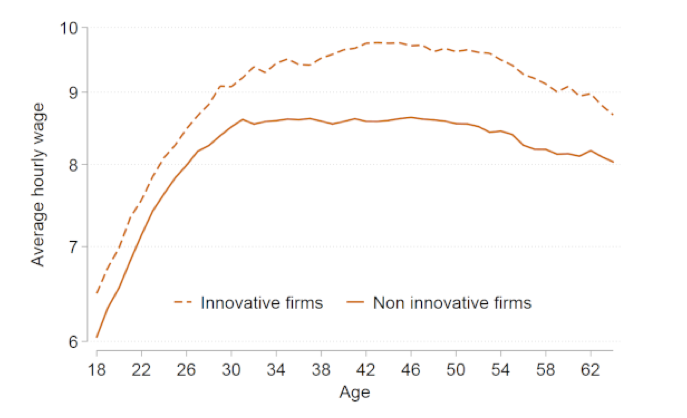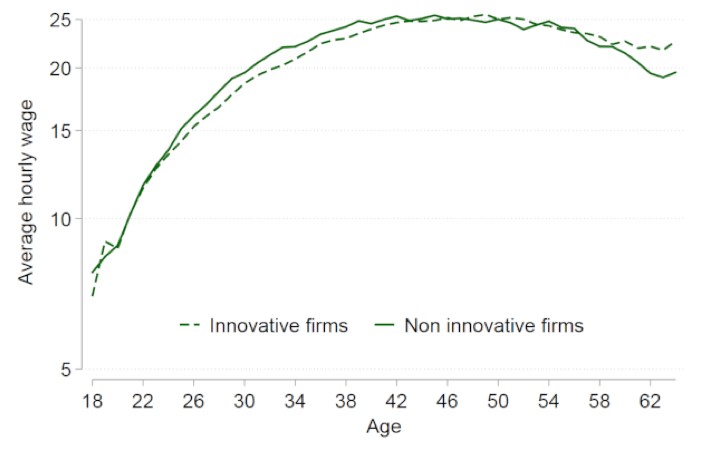Innovative firms pay workers more than others do. This fact is well known from endogenous growth theories, which state that as technology advances, innovative firms should get more rents, which should translate into higher wages. Empirically in the UK over the period 2004-2016, an average worker in a non-innovative firm was paid about 20 per cent less than an observably equivalent worker in one of the top 5 per cent most innovative firms.
Conventional wisdom on the relationship between wage inequality and technical progress suggests that the latter should increase the wage gap between skilled and unskilled labour, as it is skill-biased and makes machines more substitutable for unskilled labour than for skilled labour. However, looking at wage information from a representative sample of UK workers our research shows that some workers in low-skilled occupations also benefit from being employed by a highly innovative firm (see Figure 1 below).
Figure 1. Hourly wage at different age for workers in low skilled occupations in innovative and non-innovative firms

Source: ASHE and BERD, see Aghion et al. (2019)
Of course, as the literature on skill-biased technological changes suggests, technological progress increases the demand for cognitive skills and highly educated workers. However, this benefits all workers, irrespective of their occupation or the firm that employs them. As a result, we do not observe much wage premium from working in a highly innovative firm for this group of workers (see Figure 2). The story is different for low skilled workers. First, few of them work in the most innovative firms (on average they represent 64 per cent of the workforce in non-innovative firms versus only 20 per cent in the top 5 per cent most innovative firms). Second, those who work in these innovative firms do experience a persistent premium throughout the working life compared to other workers in low-skilled occupations.
Figure 2. Hourly wage at different age for workers in high skilled occupations in innovative and non-innovative firms

Source: ASHE and BERD, see Aghion et al. (2019)
While surprising at first, these findings are actually consistent with the view that to produce, firms need to realise different tasks that all require a combination of inputs: high skill labour (managers, engineers…), capital (computer, machinery…) and low skill labour. Using occupation level data, we show that innovative firms put more weight on tasks that require greater complementarity between these inputs, and in particular between low and high skilled labour. Thus, even the most innovative firms still value low-skill work and crucially depend on their low-educated workers to be reliable. In these types of structures, employing individuals who regularly make mistakes is extremely risky.
To go further, we consider that each worker has a set of soft skills (reliability, initiative) and hard skills (cognitive abilities). The latter is easy to observe as it is usually stated in a CV, but the former are essentially unknown by the firm at the point of hiring. Yet soft skills form a larger proportion of the abilities of workers in low-skilled occupations.
To gain intuition think of a worker in a low-skilled occupation, for example a maintenance worker, a personal assistant or a sales telephonist, who shows outstanding initiative and reliability. These attributes may be difficult to measure and verify. Yet, they allow the worker to complement the tasks performed by workers in high-skilled occupations within the firm in the sense that if performed well they can increase the productivity of the high-skilled employees, but if mistakes are made by the worker in the low-skilled occupation these can be damaging to the firm’s overall performance.
Recall that the more innovative firms are extremely sensitive to the risk of hiring a worker with the wrong skills, because their structures are characterised by a higher degree of complementarity. Hence, because they cannot precisely observe the value of a low-educated worker they will devote more time and resource to make sure to develop these skills by investing in training. Said differently, low educated workers with high soft skills command higher bargaining power in more innovative firms, and this is why we observe the wage premium of Figure 1.
We show supporting evidence for this mechanism. First, innovative firms do rely more on low-skilled occupations that are associated with a higher degree of training. Second, the tenure of workers in low-skilled occupations increases with the intensity of innovation in the firm, in line with the idea that these firms devoted more time and resource to develop some firm-specific human capital. Third, these highly innovative firms focus their attention and resource to these low-skilled occupations that are involved in tasks requiring a large degree of complementarity and outsource the others (typically cleaning and security occupations).
The most skilled workers are still the ones who benefit most from technological progress and, unlike the least skilled workers, their power in the labour market is considerable regardless of their employer. Innovative firms only have a small share of low-skilled occupations and usually outsource these tasks. Nevertheless, our results show that even in a highly technological environment where technical skills are increasingly in demand, some skills that do not require formal qualification continue to be valued by firms.
This blog was originally published by LSE Business Review. You can access the original article here.












